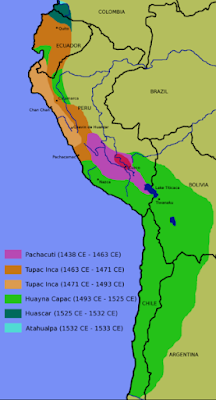Has it been a month already? Wow, times flies! Welcome to another edition of Running Through History! Last time we found ourselves in Egypt and we discussed how running was used as a means to show the strength and power of the king. Now, we are going to fly halfway around the world and 2,000 years into the future to South America and learn how running was used in an entirely different fashion!
The Inca civilization lasted from sometime in the 12th century up until the Spanish Conquest in the 16th century. While the civilization originated in modern day Cusco, in the 15th century their boundaries quickly spread into other parts of South America including Equador, Chile, Bolivia, Columbia, and Argentina, eventually making them the largest pre-Columbian empire in the Americas! The ruler of the empire was known as the Sapa Inca, or "Great Inca." Power was hereditary and was passed from father to son over successive dynasties.
 |
| Incan Expansion |
With such a massive area of land to control, it was necessary to make all parts of it accessible. The Inca, therefore, developed an extremely complex and advanced road system to connect all parts of the empire. This system spanned more than 14,000 miles and cut through jungles and over mountains (ie. the Andes). It consisted of two main north-south roads that extended throughout the empire and numerous smaller branches extending to the east and west. They even constructed rope bridges to span ravines!
 |
| Inca rope suspension bridge near Cusco |
Today, parts of these roads can still be hiked (less than 25% of the original roads exist), now known as the Inca Trail. Only a certain number of people are allowed on it each season, however, as overuse has led to some erosion.
Having an elaborate road system was good for several things, such as trading and moving goods. Another major benefit, however, was the ability to send information. Today, it is hard for us to imagine life without email. Even now, so-called "snail mail" seems out of the question, though only twenty years ago it was the norm. More than fifteen hundred years ago however, before email and even before letters, the Inca used their roads to send information verbally via the Chasquis, or Inca messengers.
As the Inca had not discovered the wheel and did not have horses, going on foot was the only means of getting anywhere. The Chasquis worked in a relay system. When a message needed to be sent across the empire it was conveyed to the nearest Chasqui. Once he memorized the message he would run in the direction of the next Chasqui, who would be waiting a few short kilometers away. The message would be passed from Chasqui to Chasqui, sometimes going as far as 250 km in a single day!
When they weren't relaying messages the Chasquis lived in huts, called Tambos, that were strategically placed along the roads. Each tambo was made up of a small shelter with storage for food and water. A messenger would only need to run as far as the next Tambo before he could pass his message on to the next Chasqui.
 |
| Tambo |
To avoid delaying delivery of the message, it was important to alert the next Chasqui that you were on your way! Therefore, each Chasqui carried with him an instrument called a Pututu, a trumpet made from a shell, that they would sound as they approached the next Tambo. In addition to the Pututu, Chasqui runners would also carry one or more quipus (knotted cords that recorded numeric values) and a qipi bag on their backs to carry valubles.
In the event of an emergency, such as an invasion, a bonfire could be lit near each Tambo. When a nearby Chasqui saw this he would light his own fire and it would relay on and on until it reached the capital and alerted the Sapa Inca.
Only the strongest and fittest males were chosen to be Chasquis. You had to have both speed and endurance as you likely had to run many miles a day. Runners had to contend with the weather and the altitude of the Andes mountains, usually wearing attire made from wool and cotton (no tech shirts back then!). The Inca roads were not paved like Roman roads. Even though there was an attempt to clear them of debris, Chasquis still had to run over tough terrain, and in sandals no less! As far as fuel goes, their diets probably consisted of fish, quinoa, llama, and potatoes.
Unfortunately, with the arrival of the Francisco Pizzaro and the Spanish in 1526, less than a hundred years after the Inca empire had been firmly established, the downfall of their civilization began. Through battle and the introduction of disease, the Spanish eventually overtook the Inca. The Inca roads, which had once been so beneficial to their society, unfortunately probably aided in the rapid spread of smallpox, Typhus, influenza, and other diseases. Not long after the conquest was finalized, many of the roads were destroyed and, no doubt, the relay message system was dismantled.
Despite their brief existence in history, the Chasquis are still a popular topic of discussion in Peru today! Many companies that host hikes of the Inca Trail have their own "Chasqui Adventures." Peru even designed a caraciture of a Chasqui to be their mascot when the country hosted the Copa Americana in 2004!
This has been another edition of Running Through History! Stay tuned for the next post on October 1st!







you should have used my photos from machu picchu! boo!
ReplyDelete